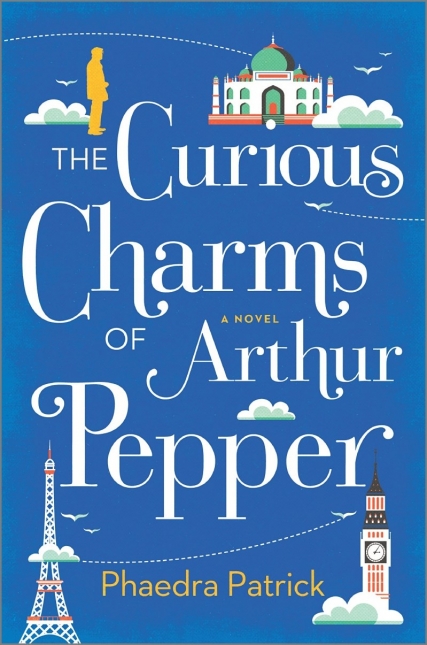The Curious Charms of Arthur Pepper: A Novel
- By Phaedra Patrick
- MIRA
- 336 pp.
- Reviewed by Erika Swyler
- April 27, 2016
A delightful, occasionally uneven story of a widower who comes of age through grief

In Phaedra Patrick’s thoughtful debut, The Curious Charms of Arthur Pepper, Arthur Pepper, 69, has been widowed for a year. He is comfortable in his mourning but has reached the point at which it must end, one way or another. His children and neighbors are concerned, and their worry is beginning to make him uncomfortable. If there is anything he dislikes, it’s making himself or others uncomfortable.
Determined to start moving on, Arthur begins to clear out his deceased wife, Miriam’s, clothing. While doing so, he discovers a charm bracelet she had hidden away, the titular charms that lead Arthur on a journey to learn about the woman his wife was before she married him.
The book relies on a straightforward quest conceit. Each charm has a story for Arthur to unravel, and by journey’s end, he will either understand his wife more or know her less. It is, in some ways, an expected voyage of self-discovery, a marked progression through the stages of grief, and yet it would be wrong to dismiss the work so lightly.
The joy — and it is difficult to refrain from saying charm — lies in Patrick’s execution. Arthur Pepper is delightfully rendered through his interactions, or lack thereof, with the world. He’s a friendly, familiar hero, a slightly bewildered English grandfather so endearing that we’re more than willing to follow him through his late-in-life coming-of-age.
Arthur’s quest begins with a small elephant charm, which handily (rather too much so) has a phone number engraved on it. The number belongs to Rajesh Mehra, a man in India to whom Miriam had been a nanny. Arthur didn’t know his wife had ever lived in India.
Now middle-aged, Rajesh reveals he had a terrible childhood crush on Miriam, which ended in disaster. It’s a variety of love that Arthur, having met Miriam as an adult, couldn’t experience. Rajesh leaves Arthur with a former address for Miriam, which is, again, a convenient clue as to the next charm on the bracelet, and Arthur’s next port of call.
If each clue leading from charm to charm feels too easy, it’s the sort of detail that can be overlooked when considering the richness of the stories connected to each charm. At every juncture, Arthur encounters a different permutation of love: a young man infatuated with his nanny; an eccentric older man with his younger wife who stayed by his side through drugs, bohemian orgies, and loss of fortune; a May/December homosexual relationship; artist and muse; young love cut short by death; and a single, older woman married to her work.
Confronted with these varied connections, and in light of what he viewed as his stable, somewhat staid marriage, Arthur asks a question that has haunted every relationship: Was I enough?
The temptation is to approach the book blithely, as the prose has a cheerful bounce and at times even veers into slapstick comedy (there is memorable scene between Arthur, his luggage, and a shrub), But Patrick is at her best when focused on love’s bleaker outcomes. The book achieves something of a gut punch: What if the relationship that keeps us alive is destroying the other person in it? It’s a deft bit of work.
The book stumbles at moments into being too on-the-nose. Arthur has the tendency to point out exactly what he’s doing, just in case the reader has missed it. “‘I am learning more about myself, too,’ he admitted. ‘With each person I encounter, with each story I hear, I feel as if I am changing and growing. And maybe others benefit a little from meeting me also.’”
Moments like these jolt the reader out of the narrative. There is also a subplot involving Arthur’s daughter, Lisa, who is recovering from a tragedy of her own. Lisa’s struggle gives light to the reasons behind the strained relationship between Arthur and his children since Miriam’s death, but her chapters feel like a diversion from Arthur’s story rather than a fully realized arc.
Miriam, the late wife and subject of so many questions, is never fully revealed. While the book hinges its plot on discovering who she was, Miriam herself is not defined. Instead, we discover the ways in which people loved her.
Ultimately, this is Arthur’s book, and perhaps it is better for the focus of his desire to remain oblique in exchange for an emerging clarity about himself. These are Arthur Pepper’s charms, not Miriam’s, and Arthur is a delightful character indeed. One leaves the book wishing he’d add a charm for himself.
Erika Swyler lives and writes in Long Island, NY. Her novel, The Book of Speculation, was one of BuzzFeed’s 24 Best Fiction Books of 2015, a 2015 Barnes & Noble Discover Great New Writers selection, an Indie Next List selection, and one of Amazon’s Best Debuts of 2015. Follow her on twitter at @erikaswyler.

